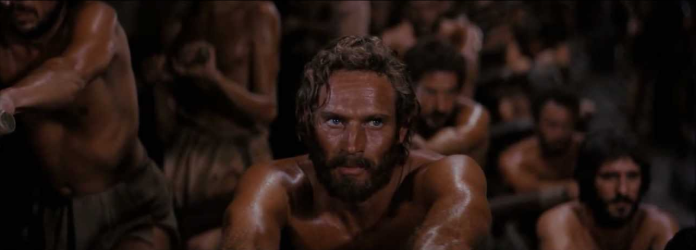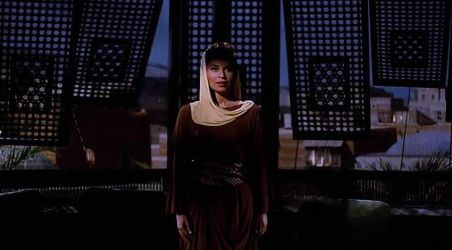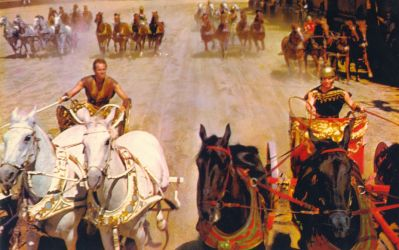According to Wikipedia, 1959 saw the popularization of the sword-and-sandal epic through a smash-hit Italian film distributed in America as Hercules, starring Steve Reeves. No citation is given for this, but one wonders if another little film—you probably haven’t heard of it—called Ben-Hur: A Tale of the Christ was a factor as well. A box-office monster, this film ranks #14 in the all-time adjusted-for-inflation box office—and as I like to point out, the adjusted-for-inflation does not adjust for population. Just as with TV 60 years ago, movies like this had an outsized influence compared to, say, the #15 film Avatar.
It won 11 Oscars, an honor only shared with two other movies, Titanic and Lord of the Rings: The Return of the King. And while Ace’s love of 1982 is not unfounded, 1959 can give any year a run for its money: Some Like It Hot, North by Northwest, Rio Bravo, Pillow Talk, Anatomy of a Murder, Imitation of Life, The 400 Blows and on and on. As host Ben Mankiewicz pointed out in his intro, this film was so popular, the merchandising for it was bananas, and for years after it came out. You could even get Ben-His and Ben-Hur robes. As Mankiewicz doesn’t point out, making this movie 10 years later would’ve been utterly unthinkable.
None of us had ever seen Ben-Hur, but not one of us balked at the three-and-a-half-hour running time. (And when movies of yore ran this long, they put in an intermission at least!)

TFW you have to pee and you’re not sure when the intermission is coming.
The plot is basically Gladiator, if that film had a fourth act where the hero meets Jesus and comes to eschew revenge. Ben-Hur (Charlton Heston) is a wealthy Jewish prince whose childhood friend, Messala (Stephen Boyd) has returned to Judea to help put down the rebellious Jews. Miffed by Ben-Hur’s refusal to betray his people, Messala frames him and has him sentenced to a slave galley. Through a twist of fate, Ben-Hur survives the galleys only to become a prominent figure in Rome, whereupon he uses his freedom to return to his homeland in search of revenge. INTERMISSION. (In other words, you still have half the movie to go!)
This movie is jam-packed. There is no padding here. In fact, it feels kind of breakneck, with lots left out—probably due to the fact that it’s based on the 800 page smash-hit book that unseated Uncle Tom’s Cabin as the most popular book of the 19th century. We learn, for example, that Ben-Hur drove chariots in Rome but we never see that. He’s on the galleys for years but we only see a little of that. He journeys from Rome to Jerusalem, where he meets Balthazar and lays the groundwork for the ultimate chariot race—and that’s about all we see of that journey. It’s practically a highlight reel, with no time to spare.
As a result, the acting burden falls primarily on Charlton Heston. We can only experience things through him. He won the Oscar for this role and it’s well-deserved. It was de rigeur to deride his acting skills when I was a kid, and his iconic apocalyptic roles in Soylent Green, Planet of the Apes and The Omega Man are cheesy—but that ’65-’75 period was a cheesy time. Put Heston in a big, heroic Biblical role like this (or The 10 Commandments) and he shines.

The lovely and moving Haya Harareet, a Palestinian from back when “Palestinian” meant “Jew”.
Even so, this movie works because of William Wyler, the director of some of Hollywood’s greatest films, like The Best Years of Our Lives and Roman Holiday, as well as one of the other great religious movies of all time, Friendly Persuasion (which has the most mature treatment of the challenges of faith I’ve seen from a Hollywood film). Wyler had turned down Ben-Hur repeatedly because he wasn’t a Big Spectacle picture kind of guy. Ultimately, producer San Zimbalist convinced him by saying the movie needed intimacy—the spectacle would take care of itself. So Wyler brought the human interest, and let the spectacle take care of itself. (Wyler didn’t even direct the chariot scene!)
And it is a spectacle! A glory of mattes, rear projection, models, set design and lighting, all skillfully blended give a sense of real time and place. It all reads beautifully, even if it’s not perfect. The long shots of the fleet of galleys are pretty clearly models, and if you’re really paying attention, you can see the little stick figures. But you do have to be looking, for the most part. (I do look because as much as CGI bores me—a bunch of guys like me typing on computers to move pixels around—I love practical effects and all the various crafts involved.)
The chariot race is still spectacular. It’s Mad Max: Fury Road level of breathtaking, with horses and chariots flying everywhere and miraculously no stunt men dying.

Me trying to merge onto the 101 in the morning.
What takes the movie beyond the traditional sword-and-sandals revenge flick is that the chariot race, which is the climactic action set piece of the film is book-ended by Ben-Hur’s redemption, where he realizes revenge isn’t going to save him or restore his mother and daughter. The peripheral-character-in-the-life-of-Jesus trope was a common one for centuries and it is done expertly here. The Flower especially appreciated the trope of never showing His face.
Helluva flick, is what I’m saying. And crazy influential, too, of course. Obviously the inspiration for the Coen brothers Hail, Caesar!, we also couldn’t help but notice that Life of Brian leans heavily on this (and Spartacus) for its portrayals of the Romans in Judea. What sort of surprised me was how some key points of Army of Darkness were echoes of this movie. For instance, the opening narration “My name is Ash, and I’m a slave.” is shot in a very similar way to Ben-Hur’s enslavement and the music cribbing from Miklos Roza’s brilliant score. To say nothing of the bizarre windmill scene where the tiny Ashes yell “Ramming speed!”
Those just leapt out at me. I’m sure a brief review of IMDB’s connections page would reveal much more.
We all loved it, and are primed for next month’s classic: True Grit.

“Stwike him, Centuwion! Vewy woughwee!”
